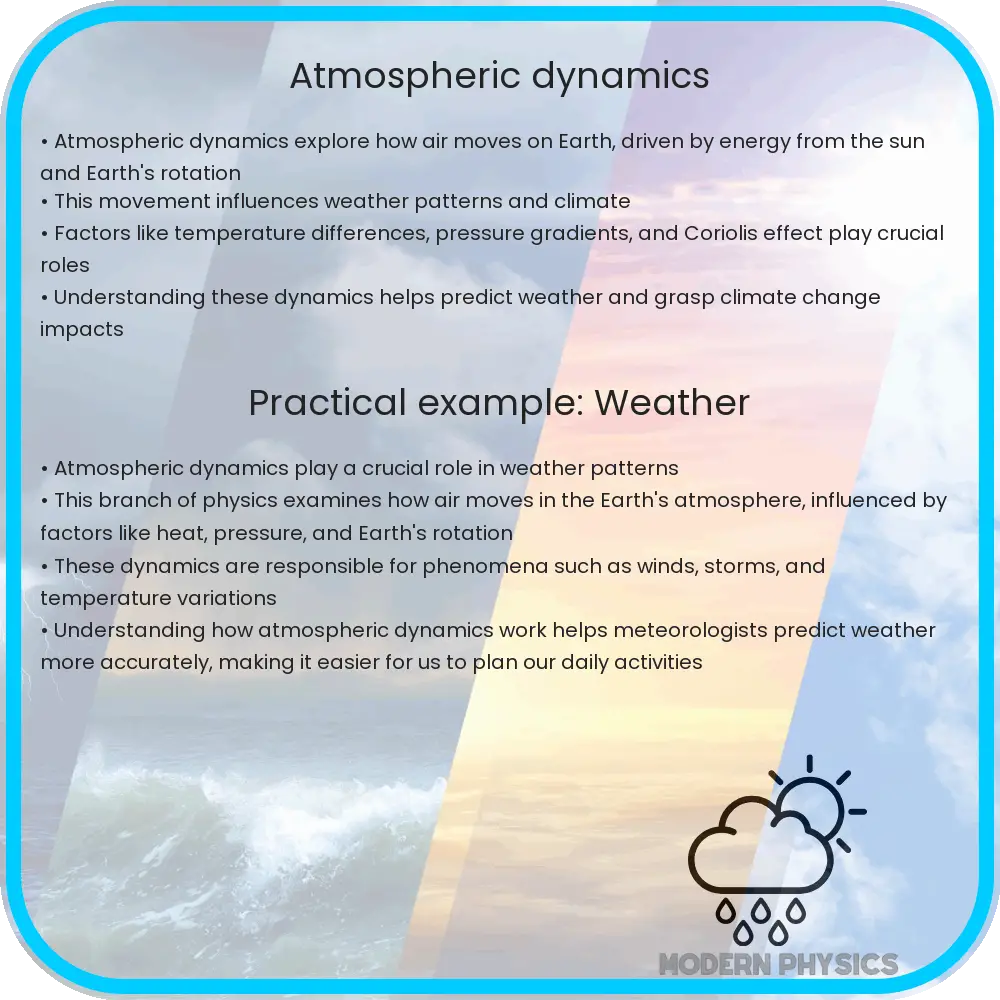Explore the role of atmospheric dynamics in shaping Earth’s weather and climate patterns.

Understanding Atmospheric Dynamics and Their Impact on Weather and Climate
Atmospheric dynamics play a crucial role in shaping the weather patterns and climate conditions we experience on Earth. By studying how air moves through the atmosphere, scientists can better predict short-term weather changes and understand long-term climate trends.
The Basics of Atmospheric Circulation
At its core, atmospheric dynamics involve the movement of air driven largely by the heat from the sun. This movement is also influenced by the rotation of the Earth, which applies a force known as the Coriolis effect. These factors combined lead to a variety of weather systems and climate phenomena.
Several layers make up Earth’s atmosphere, each interacting differently with heat and light. The lowest layer, the troposphere, contains the majority of our weather systems. Above this, the stratosphere, mesosphere, and thermosphere extend upwards to the edges of space. Understanding each layer’s role is crucial for studying atmospheric dynamics.
Solar Heating and Its Effects
The sun’s heat is not distributed evenly across the Earth due to the spherical shape of the planet and its tilted axis. Areas around the equator receive more direct sunlight than regions near the poles. This uneven heating causes air to warm, expand, and rise near the equator, creating a low pressure area. Cooler, denser air then flows in from higher latitudes to replace the rising warm air. This cycle, known as convection, forms the basis of our global circulation patterns.
Global Circulation Patterns
The major global circulation cells are the Hadley, Ferrel, and Polar cells, each functioning as a convection loop between specific latitudes. The movement within these cells creates predominant wind patterns and influences the climate zones across the globe:
- The Hadley Cell operates between the equator and about 30° latitude. Air rises at the equator and moves towards the poles before descending around 30° N and S latitudes, creating subtropical high-pressure zones.
- The Ferrel Cell is found between 30° and 60° latitudes. Air flows towards the poles and rises near 60° latitude, creating low-pressure zones.
- The Polar Cell works between 60° and the poles. Cold air descends and flows towards lower latitudes.
These cells are crucial in distributing heat from the equator towards the poles, thereby moderating global temperatures and influencing weather patterns.
The Coriolis Effect and Weather Patterns
Earth’s rotation influences wind directions through the Coriolis effect. This phenomenon causes moving air (and water) to turn right in the northern hemisphere and left in the southern hemisphere. This effect shapes the direction of wind patterns and influences the rotation of large weather systems like hurricanes and other cyclonic storms.
Understanding the Coriolis effect is essential for accurate weather forecasting and for explaining the movement of ocean currents that are critical to global climate systems like El Niño and the Gulf Stream.
Climate Impact and Long-Term Changes
Long-term changes in atmospheric dynamics can significantly affect the Earth’s climate. Factors such as volcanic eruptions, greenhouse gas concentrations, and solar radiation changes can alter the global circulation patterns we currently understand. Predicting these changes requires sophisticated models that take into account various aspects of atmospheric physics, chemistry, and interactions with the ocean and biosphere.
By studying how these dynamics are changing, scientists can better predict the impact of global warming, such as more frequent and severe weather events, rising sea levels, and shifting climate zones.
Continued research into atmospheric dynamics not only enhances our ability to forecast weather and understand climate systems but also helps predict and mitigate the effects of climate change on global ecosystems and human societies.
Technologies in Atmospheric Study
To study the vast complexities of atmospheric dynamics, scientists employ various tools and technologies. Weather satellites provide a broader view of weather patterns and atmospheric changes from space. These satellites carry instruments that can measure variables like temperature, humidity, wind speeds, and cloud cover. Ground-based technologies like weather stations and radar offer detailed local data, crucial for understanding microclimates and initiating timely weather forecasts.
Airborne technologies, such as drones and specialized aircraft, are also essential. They collect data from altitudes that are difficult to reach, helping to fill in gaps between satellite and ground measurements. These methods ensure continuous monitoring and provide the data necessary for refining weather prediction models.
Education and Public Awareness
Education plays a pivotal role in enhancing public understanding of atmospheric dynamics. By informing communities about how weather systems form and the implications of climate change, individuals can make better decisions in their daily lives and support policies that protect the environment. Programs in schools, universities, and public seminars are vital in cultivating a more climate-aware populace.
Moreover, initiatives that involve citizen scientists in data collection and observation also help increase community engagement with atmospheric science. These collaborative efforts broaden the scope of research and foster a deeper public connection with the science of meteorology.
Conclusion
Atmospheric dynamics are a fundamental aspect of Earth’s climate system. Understanding these processes is crucial not only for predicting weather and preparing for climate variability but also for addressing broader environmental challenges. Scientific research supported by advanced technologies and enhanced by educational outreach empowers societies worldwide to adapt to and mitigate the impacts of climate changes. Continued exploration in atmospheric sciences holds the key to unlocking more sustainable interactions between humanity and our planet’s dynamic weather systems.
